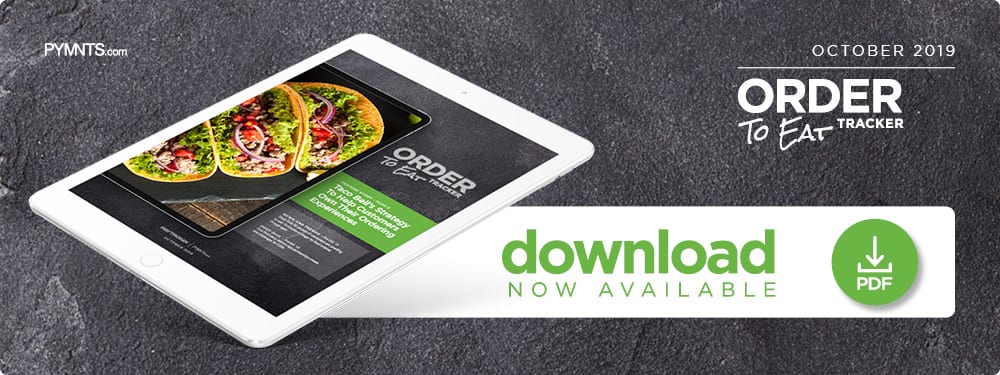Taco Bell’s Strategy To Help Customers Own Their Ordering Experiences

In the quick-service restaurant (QSR) space, sometimes the best combos aren’t on the menu. With consumers’ ordering preferences getting increasingly digital, many restaurants are turning to self-serve technology and delivery partnerships to provide enhanced omnichannel experiences. In the new Order To Eat Tracker, Taco Bell’s Senior Director of IT Rafik Hanna tells PYMNTS how the chain’s deployment of kiosks at 6,600 locations and its partnership with Grubhub are empowering customers to “own their ordering experience.”
Digital self-service kiosks and delivery options could help restaurants provide the seamless ordering experiences customers expect from their favorite brands. Several major quick-service restaurant (QSR) chains — such as McDonald’s, Panera Bread, Subway and Wendy’s — have recently stepped up their investments in self-service kiosks at their brick-and-mortar locations and have partnered with delivery platforms like DoorDash, Postmates and Uber Eats to increase their order volumes.
Taco Bell is also pursuing solutions to improve customers’ in-restaurant and home-delivery orders. The chain expanded its partnership with delivery service provider Grubhub earlier this year and is planning to install self-service kiosks across the 6,600 restaurants in its network. Rafik Hanna, Taco Bell’s senior director of digital technology, said these investments are geared toward improving ordering experiences for both in-store and remote customers. Hanna recently spoke with PYMNTS about how self-service kiosks and the company’s Grubhub partnership are modernizing Taco Bell’s ordering options and providing insights into customers’ expectations.
Enabling Customers to ‘Own Their Ordering Experiences’ With Self-Service
Taco Bell rolled out its first self-service kiosk in 2015 and has since worked to offer the technology at additional locations. The company plans to install them at all of its stores by the end of the year.
The kiosks feature 22-inch touchscreen monitors that allow customers to quickly place their orders and pay via credit cards, debit cards, gift cards and mobile wallets. They can also check out with sales associates if they want to pay with cash. Hanna said Taco Bell’s customers greatly approve of the kiosks, which help them more easily discover menu items and place personalized orders.
“Kiosks really help our customers to own their ordering experiences and make it easier to customize food the way they want it,” Hanna said.
Kiosks are particularly beneficial to the chain’s vegetarian patrons, who can use them to filter out meat-based menu items or order popular items and substitute meat ingredients with vegetarian options, like beans.
“With people trying to eat healthier, what’s super clear for us is, with our kiosks, there is no easier way to order vegetarian,” he said.
The kiosks not only promote new menu items and specialized foods, but they are also more inclusive. They offer multiple language options and are equipped with Americans with Disabilities Act (ADA)-compliant features that allow visually impaired users to plug in headphones and navigate the interface using audio cues.
Deliver for Home-Based Customers
The company also partnered with Grubhub to smooth its remote customers’ ordering experiences. The collaboration began in 2018 and was expanded nationwide earlier this year.
“Consumers want what they want when they want it and where they want it,” Hanna explained, adding that the move was crucial to providing improved ordering experiences.
The partnership saw the two companies work to integrate Grubhub into Taco Bell’s point-of-sale (POS) system. The solution utilizes geofencing capabilities that alert restaurants when Grubhub delivery drivers are nearby, allowing kitchen staff to prepare meals within minutes so customers will receive fresh orders.
On the Omnichannel Road
Taco Bell is exploring other opportunities to further enhance customers’ ordering experiences, regardless of which digital channels they use, Hanna noted. It is also beginning to invest in and test digital menu boards to offer drive-thru customers more seamless ordering experiences.
“In the past few years, there’s been so much change and digitization of that customer experience in restaurants,” Hanna stated. “We’ve been really intentional about making a dramatic shift to make Taco Bell experiences more digital.”
These efforts are also geared toward smoothing kitchen operations and helping the team members tasked with fulfilling these orders.
“We are becoming [an] omnichannel company like a lot of top retailers out there, and we’re going to see that growth and modernization of our brand continue,” he said. “We want to meet the customers where they want to be.”
Digitization and modernization mean customers can place orders from almost anywhere, and QSRs must be ready to seamlessly fulfill their requests across a wide range of channels. Digital self-service kiosks and delivery partnerships are likely to play big roles in helping customers find their ideal ordering experiences.
